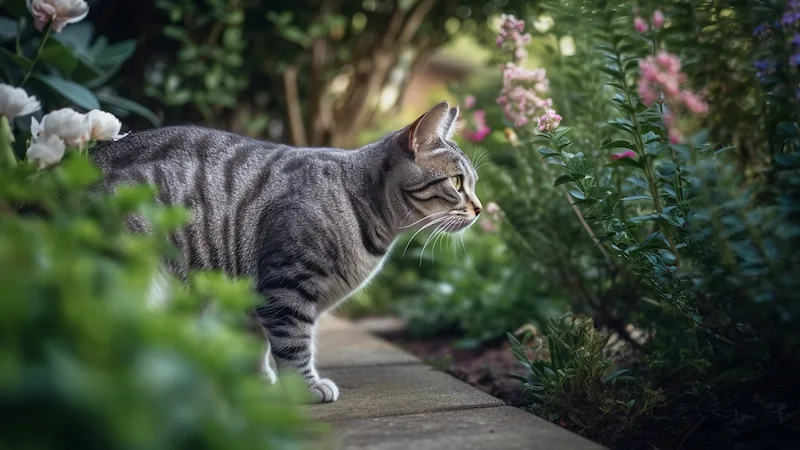6 Tips and Tricks to Keep Your Outdoor Cat Safe and Happy
While it can be tempting to let your cat roam outside, there are risks and dangers to cats living outdoors, but you can take precautions to keep your cat safe.

As cat owners, we want our feline friends to have the best of both worlds: the freedom to explore the great outdoors and the safety and security of our homes. While it can be tempting to let your cat roam outside, there are risks and dangers to cats living outdoors. If your cat insists on being outside, take precautions to help keep them safe and happy.
Safe Outdoor Access
First and foremost, it's important to give your cat the option to come inside whenever they want. Cats are independent creatures, and they need to be able to come and go as they please.
Make sure your cat has access to a cat door or an open window, so they aren’t stuck outside. This also gives them a safe space to retreat to if they feel threatened, scared, or if they simply want to come inside for a cat nap.
Easy Access to Water
Make sure your outdoor cat always has access to fresh water. Cats are notorious for not drinking enough because they don’t tend to feel thirsty, so it’s up to you as their owner to entice them to hydrate.
Consider providing them with a water fountain or a self-filling water bowl—they’re bound to get thirsty after a few hours of outdoor time! It’s also a good idea to only feed your cat indoors to prevent other animals from stealing their food.
GPS Trackers and Microchips
If your cat goes outside, they’ll need to have a collar with your updated contact information on it. You can also invest in a GPS tracker to attach to their collar. This can help you keep tabs on your cat's whereabouts and make sure they don’t go too far from home.
Keep your cat’s microchip up to date with your current contact information, in case they get lost or injured while outside, or their collar is lost while they’re adventuring.
Road Safety
It’s a hard truth, but outdoor cats have a lower life expectancy, and a huge reason is because of cars. Ideally, if you live on or near a busy road, your feline friend should be indoors only. Instead, you can train your cat to stay in your yard and the surrounding areas. You could also go outside with them and supervise their outdoor time to ensure their safety.
Flea & Tick Prevention
Flea and tick medication is a good idea for all cats, even if your cat is a house cat. If your cat does venture outside, flea and tick prevention is a must. These common parasites can cause a range of health problems, including skin irritations, infections, and the transmission of diseases.
Talk to your vet about the best flea and tick treatment for your cat. There are a variety of treatments available, including spot treatments and oral medications. Make sure you follow the instructions carefully to ensure your cat is protected.
Fleas and ticks thrive in tall grass and other vegetation. Regularly mowing your lawn and keeping it tidy can help reduce the risk of infestations.
Regularly check your cat for fleas and ticks, especially after spending time outdoors. Look for small, dark specks on their skin and fur, as well as any signs of skin irritation or itching.
Alternative Options to Free Roaming
If you're concerned about the safety of letting your cat roam freely outdoors, there are several alternative options to consider. These include:
Cat Enclosures:
Also known as catios, these
provide a safe and secure environment for your cat to enjoy the outdoors while staying protected from potential dangers such as cars or predators.
Leash Training:
While it may take some time and patience, some cats can be trained to
. This allows them to safely explore the outdoors while remaining under your supervision and control.
Indoor Enrichment:
Providing your cat with a
stimulating indoor environment
can help satisfy their natural instincts to explore and play. You can do this by setting up perches, scratching posts, and interactive toys to keep them entertained.
Providing your cat with safe outdoor access is important for their physical and mental well-being, but it's also essential to keep them protected from potential hazards. By following simple best practices, you can help keep your outdoor cat healthy and safe.
Outdoor cats have unique medical needs due to the extra risks they have compared to house cats. Getting pet insurance is a great way to help protect your cats, indoor and out. Learn about the coverage available through AKC Pet Insurance and get a quote today.
Aimee is a New Jersey native currently living in Richmond, Virginia with her husband and crew of four cats. She has an English degree and when she isn't writing for AKC Pet Insurance, you can find her drinking seltzer, painting, watching reality TV shows, and trying to wrangle her cats into sweaters.
READ MORE ARTICLES